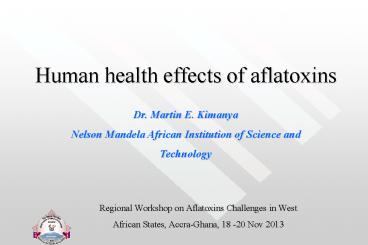Human health effects of aflatoxins - PowerPoint PPT Presentation
1 / 13
Title:
Human health effects of aflatoxins
Description:
Title: Influence of a Complementary Food on the Growth and Iron & Zinc Nutritional Status of Children 6 Month 1 Year old in Kilosa District, Tanzania – PowerPoint PPT presentation
Number of Views:722
Avg rating:3.0/5.0
Title: Human health effects of aflatoxins
1
Human health effects of aflatoxins
Dr. Martin E. Kimanya Nelson Mandela African
Institution of Science and Technology
- Regional Workshop on Aflatoxins Challenges in
West African States, Accra-Ghana, 18 -20 Nov 2013
2
Toxicity of aflatoxins
- Acutely toxic
- Immunosuppressive
- Increase HIV viral load in infected individuals (
in Ghana - Jolly et al. 2013) - Mutagenic
- Carcinogenic
- Impair growth in young children
- Aflatoxins are classified as compounds
carcinogenic to humans
3
Health effects
- High (acute) levels of contamination (above 200
ppb) - Direct outbreak of human disease e.g.
Aflatoxicosis in Kenya, 265 people died - Acute illness and death, usually through liver
cirrhosis - Low (chronic) levels of contamination
- Child stunting and underweight (Togo, Benin
Gong et al, 2004 and Tanzania - Immune suppression (The Gambia-Turner et al.
2003) - Acute and chronic contamination
- Liver cancer
4
Liver cancers cases attributable to aflatoxins
(Liu and Wu 2010)
- 25,200 155,000 cases of liver cancer are
attributable to aflatoxins - This is up to 28.2 of all global liver cancers
- Most cases occur in sub Sahara Africa, Southeast
Asia and China - These regions suffer from high Hepatitis B virus
(HBV) infection and uncontrolled aflatoxins in
foods
5
Global prevalence of chronic Hepatitis B virus
infection 1997
6
HBV infection contributes to liver damage that
is potentiated by chronic aflatoxin exposure
- The virus may interfere with aflatoxin
detoxification process - HBV-infected hepatocytes are prone to aflatoxin
induced DNA damage - Replication of the virus may contribute to the
mutation potentiated by aflatoxins
7
Risk for primary liver cancer attributable to
aflatoxins Exceeds 1case per year per 100,000
people
Country HBV positive (Cases/year/100,000 people) HBV negative (Cases/year/100,000 people)
Mozambique 54 1.8
Nigeria 68.1 2.27
Kenya 39.9 1.33
Tanzania 15.0 0.5
USA 0.008 0.003
The risk for HBV positive is up to 30 times
higher than for HBV negative (Liu and Wu 2010)
8
Risk of liver cancer is very high in Africa and
is related to high aflatoxin exposure (Shephard
2008)
Country(food item) Food intake (g/person/day) Exposure (ng /kg body weight /day) Risk (Cases/year/100,000 people) MoE
Kenya (Maize) 400 353 29.2 0.5
Ghana (Kenkey) 1000 850 70.1 0.2
Tanzania (Local brew) 1048 402 33.1 0.4
Gambia (Groundnuts) 65 16 1.3 10.6
- Risk exceeds 1 case per year per 100,000
- Margin of Exposure (MoE) is lower than 10,000
9
Options to minimize exposure
- Reduce contamination in food
- Setting maximum tolerable limits (MTL)
- Applying GAP, sorting, dehulling etc
- Reduce consumption of susceptible food
- Reduce both contamination and consumption
10
Challenges for exposure reduction
- Reliance on one or two crops for food
- High occurrence of aflatoxins in the foods
(staples) - Low level of awareness on the problem of
aflatoxins contamination and potential mitigation
measures - Low capacity for risk assessment and management
for aflatoxins
11
Population liver cancer risk (cancers per 100,000
population) for different food intakes at
different aflatoxin B1 contents (Shaphard 2008)
Food Intake (g person31 (60 kg) per day) Food Intake (g person31 (60 kg) per day) Food Intake (g person31 (60 kg) per day) Food Intake (g person31 (60 kg) per day) Food Intake (g person31 (60 kg) per day) Food Intake (g person31 (60 kg) per day)
Aflatoxin B1 (ng/g) 10 50 100 150 200 400
1 0.014 0.069 0.14 0.21 0.28 0.55
2 0.028 0.14 0.28 0.41 0.55 1.1
5 0.069 0.34 0.69 1 1.4 2.8
10 0.14 0.69 1.4 2.1 2.8 5.5
20 0.28 1.4 2.8 4.1 5.5 11
The blue colour values represents risk of concern
( above 1 per 100,000)
12
Conclusions
- Risk of aflatoxins exposure in Africa is very
high (MoE lt 10 in most countries) - Risk of liver cancer attributable to aflatoxins
in Africa is unacceptably high (More than 1case
per year per 100,000 people) - Take urgent preventive measures
- Incorporate HBV vaccination in national
vaccination programs - Diversify our diets to include foods that are
less susceptible to aflatoxins - Initiate aflatoxins control programs
- Raise awareness on aflatoxins
- Build capacity for aflatoxins risk assessment,
management and communication - Include aflatoxin exposure in national food borne
surveillance systems
13
Thank you

